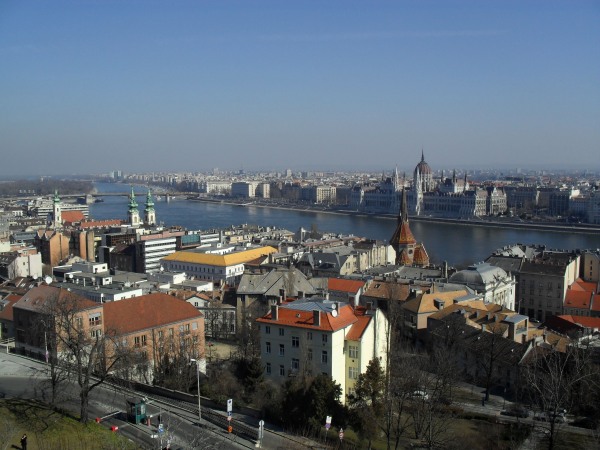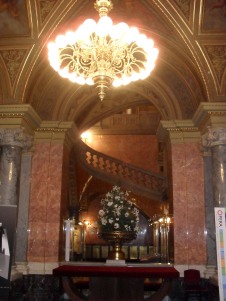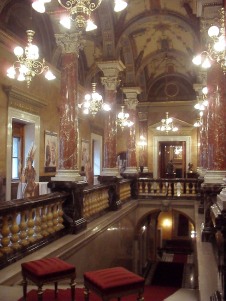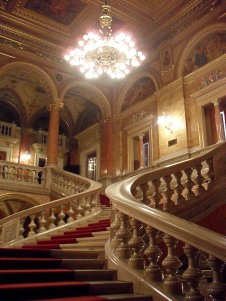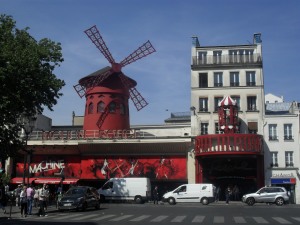Budapest
Budapest was more expensive than I expected it would be. I’ve found that European countries that aren’t on the euro, and have such high exchange rates that you feel like a millionaire, are often cheaper. Hungary, or at least Budapest, wasn’t one of them.
One euro gets you 272 forint (HUF), but you go through it very quickly. On the first day I spent 10,870 HUF (about €40) – way over my budget. On my second day I was very good – 390 HUF (about €1.45). On my third day I gave up – how could I be in Budapest and not visit the Parliament, the House of Terror or the Opera? (I didn’t get to the Parliament – our schedules didn’t align – but the intention was there.) I also bought my ticket to Bucharest for 14,620 HUF (a seat, because I was too poor for a couchette), which meant that I spent €70.42 on day three. The budget was officially blown.
Sigh. Hopefully Romania, Bulgaria and Turkey are cheaper.
The thing is, whenever I wasn’t worrying about money my trip was so much better.
On my first day I was quite good – I knew the 72hr public transport ticket (3,850 HUF) would even out, and that I would only do the thermal baths once. It was only after buying food that I started to worry.
The second day was also good, but I found myself distracted as I started to get hungry, wondering whether I could really afford to buy something decent, and I found myself going up to expensive attractions and turning away.
Never one for self-deprivation, on the third day I was back.
But enough writing about money – let’s go onto Budapest!
I arrived at 9am on Tuesday and was greeted by Aurélien, Pierre from Warsaw’s friend. After dropping my things at his place, we walked around the city and he even let me sit in on one of his classes (he’s teaching French at a school in Budapest). I sat at one of the desks behind the students and, although he didn’t call on me, I think I could have kept up with the thirteen-year-olds.
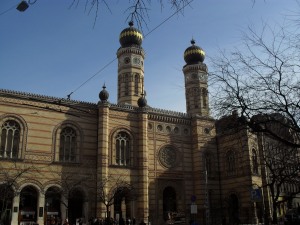
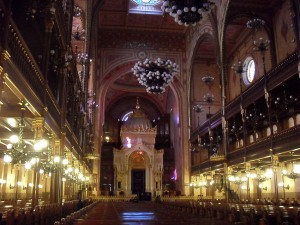
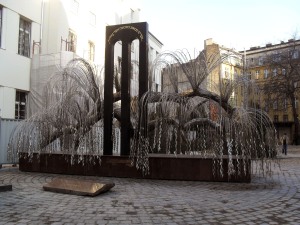 Afterwards we visited the Dohány Street Synagogue and Jewish museum (admission was 850 HUF with my Youth card). This is the first synagogue I’ve visited in my travels and, upon entering, I couldn’t help but exclaim “wow!”
Afterwards we visited the Dohány Street Synagogue and Jewish museum (admission was 850 HUF with my Youth card). This is the first synagogue I’ve visited in my travels and, upon entering, I couldn’t help but exclaim “wow!”
Built in the 1850s, the vaulted ceilings of Europe’s largest (and the world’s second-largest) synagogue tower 43m high, with two levels of balconies on either side of the nave. Huge chandeliers hang from the centre of the ceiling and smaller ones hang over all three levels.
Next to the synagogue is a small graveyard – the bodies of Hungarian Jews were buried here in a mass grave, and people who knew some of the victims’ names put small tombstones in the garden. There is now also a small monument and a plaque on the back wall with a more complete list of names. If you continue behind the synagogue, there are three monuments to the Holocaust – a free-standing stained-glass window, a wall of little arched holes named for the victims filled with pebbles, and the Emmanuel Tree.
The Emmanuel Tree is a weeping willow made of stainless steel and silver, and was design to resemble an upside down menorah. The names of Hungarian Holocaust victims are engraved on 4000 of its leaves.
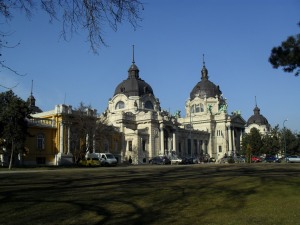 After Dohány Synagogue, we visited the thermal baths at Széchenyi Spa (prices start at 3,100 HUF). The spa’s walls enclose a large courtyard with two hot pools (34 ºC and 38ºC) and a swimming pool (28ºC) – on a chilly night, plumes of white steam flew into the air like fog, and being under the water was like being in front of the fire, wrapped in a doona with a hot chocolate in a storm. Inside there are several saunas, a cold-water pool, as well as several thermal mineral baths, each with different minerals and, consequently, different smells. After soaking in a mineral bath, Aurélien asked if I wanted to try a sauna (I’d previously said I loved them, and he said he hated them).
After Dohány Synagogue, we visited the thermal baths at Széchenyi Spa (prices start at 3,100 HUF). The spa’s walls enclose a large courtyard with two hot pools (34 ºC and 38ºC) and a swimming pool (28ºC) – on a chilly night, plumes of white steam flew into the air like fog, and being under the water was like being in front of the fire, wrapped in a doona with a hot chocolate in a storm. Inside there are several saunas, a cold-water pool, as well as several thermal mineral baths, each with different minerals and, consequently, different smells. After soaking in a mineral bath, Aurélien asked if I wanted to try a sauna (I’d previously said I loved them, and he said he hated them).
“Sure, but maybe the 60ºC one – I haven’t been in a sauna for a while.”
“No,” he shook his head. “The hottest!”
“Okay,” I quailed inwardly, “how hot is it?”
“80ºC.”
We hopped in with the intention of staying for ten minutes. After seven, Aurélien said he couldn’t take anymore and had to leave. I gratefully followed him out, relieved that I hadn’t been the one to back down. Afterwards we both agreed that it nearly killed us.
Unfortunately we had to go back outside to return to the locker rooms, and those thirty seconds across the freezing pavement in bare feet were unbelievably painful.
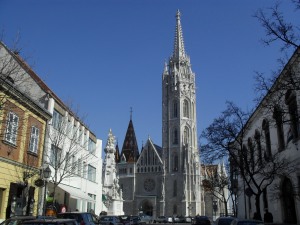 Over the next two days I was by myself and, along with general wandering around, I visited Buda Castle and its surrounds, the State Opera House, the City Park and the House of Terror (which I’ll write about in a separate post).
Over the next two days I was by myself and, along with general wandering around, I visited Buda Castle and its surrounds, the State Opera House, the City Park and the House of Terror (which I’ll write about in a separate post).
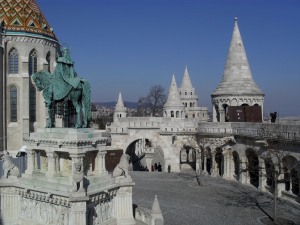
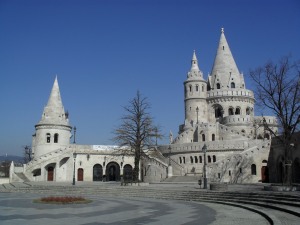 Buda Castle rests on a hill over Budapest and houses two museums, and there are three more in the district, though you don’t need to visit them to appreciate the area. I spent a few hours wandering through the streets and to each of the castle gates (one which looked like a wrought iron spider’s web with a crow resting on top), admiring the elegance of the castle as well as that of the green, yellow and white buildings in the surrounding area.
Buda Castle rests on a hill over Budapest and houses two museums, and there are three more in the district, though you don’t need to visit them to appreciate the area. I spent a few hours wandering through the streets and to each of the castle gates (one which looked like a wrought iron spider’s web with a crow resting on top), admiring the elegance of the castle as well as that of the green, yellow and white buildings in the surrounding area.
My favourite part was the Fishermans’ Bastion – the fortress protecting the castle, right behind Matthias Church. Constructed entirely in white stone, the bastion looks like something from a fantasy film. Walking through the white colonnades and looking out over Pest, I felt like a dragon could land on one of the towers at any moment and whisk me away.
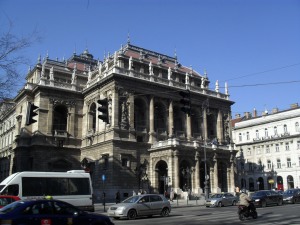 The State Opera House (1,900 HUF with student/Youth card) is gorgeous with red carpets, green, pink and grey marble, frescoed ceilings based on Greek mythology, and gold-leaf. Although it was supposed to just contain Hungarian materials, it used timber from Croatia and marble from Italy as well (there is also fake-marble from Hungary, which is more expensive than the genuine stuff).
The State Opera House (1,900 HUF with student/Youth card) is gorgeous with red carpets, green, pink and grey marble, frescoed ceilings based on Greek mythology, and gold-leaf. Although it was supposed to just contain Hungarian materials, it used timber from Croatia and marble from Italy as well (there is also fake-marble from Hungary, which is more expensive than the genuine stuff).
At the time of its construction, 1875-1884, the State of Hungary ran into financial difficulties, so most of the funding came from Habsburg Emperor Franz Josef. He gave the money on the condition that the completed Opera House would be smaller than the one in Vienna. With 1,200 seats it is about half the size of the Viennese Opera House, but twice as beautiful (according to the tour guide).
Apparently this Opera House has some of the best acoustics in the world – as the pillars on the auditorium’s balconies carry sculptures of angels holding instruments, the legend is that the angels join in the performance every night with their instruments.
At the end of Andrassy Boulevard, the City Park is worth a visit too. This is where Széchenyi Spa is located, along with Heroes’ Square, and Vajdahunyad Vára. Vajdahunyad Vára is a castle built for the 1898 world fair – it hosts an agricultural museum, but I just went to admire the buildings.
So Budapest was awesome, the budget was blown, and I’m going to try to behave myself in my next few destinations.
